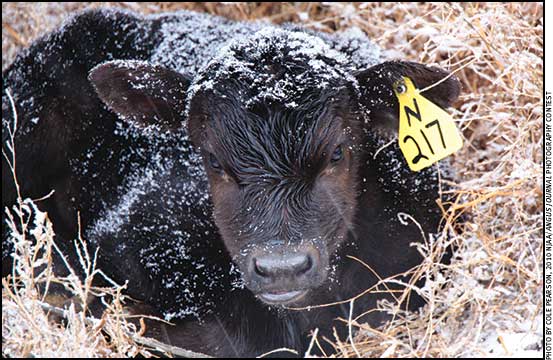
Dealing with Cold Stress in Calves
Baby calves are more vulnerable to cold weather than older cattle and may need special care.
Cold temperatures bring additional challenges when accompanied by wind or wet weather. Russ Daly, Extension veterinarian and associate professor at South Dakota State University, says that even very young calves can handle fairly cold temperatures if they are dry and have the insulating effect of a fluffy hair coat.
It’s also crucial to make sure calves suckle adequate colostrum very soon after birth to have adequate energy to keep warm.
“A calf is born with less than a day’s worth of energy, in the form of brown fat, to burn for body heat. If he doesn’t get colostrum, once that brown fat is gone there is no energy available for the calf to maintain or regulate body heat,” says Daly.
Colostrum has two to three times more fat than regular milk, Daly explains. It’s a very good first meal for young calves and really makes a difference in getting them up and going, he adds. A calf that has nursed a full feeding of colostrum can stay warmer in cold weather.
“Young calves need a dry environment. They dry off quickly if they have a good mother that licks them up immediately after birth. Sometimes in cold weather it’s best to help with that process,” says Daly.
Getting a calf dried off and colostrum in its belly enables it to handle a lot more cold.
It’s also important to have bedding for baby calves.
“There’s not much body mass in a small calf; these babies chill more quickly than a larger animal. Bedding helps insulate the calf, making a separation between the calf and frozen ground, snow, cold concrete, etc. This is very important in helping calves stay warm,” says Daly.
Frostbite can be an issue in calves born during cold weather. Extremities suffer first.
“Most people who calve early calve inside, but occasionally a calf is born outside and freezes its ears. After the calf is dry there is much less risk for frostbite, unless a calf is suffering from a debilitating condition such as scours and dehydration,” says Daly.
In that situation there is less blood flow to the extremities and they may freeze.
If the newborn has frozen ears, tail or feet, care should be taken to not damage the tissues when trying to warm the calf.
“If you suspect frostbite, remove the calf from cold conditions, but don’t warm the ears or feet too quickly. Use warm water and towels, not hot water, and don’t rub the area too much or it may damage the tissue more,” he says.
Older calves are less at risk. There is more blood flow to the extremities and the calves are more adept at getting out of the wind. Windbreaks are crucial, but he cautions about shelters for young calves that might congregate them in that one area. It may keep them out of the wind, snow and rain, but also concentrates the pathogens that cause disease. If shelters are used, they should be moved frequently to clean locations with clean bedding, explains Daly.

Editor’s Note: Heather Smith Thomas is a cattlewoman and freelance writer from Salmon, Idaho.






